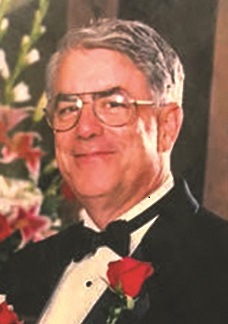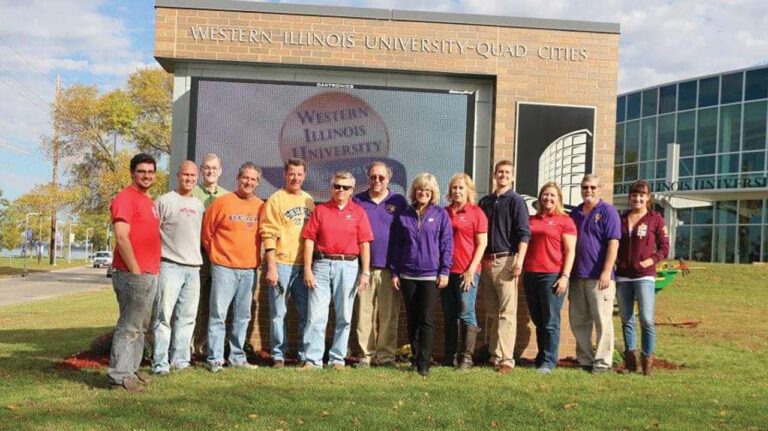
As Renew Moline captains the effort to create a pivotal plan to transform the city’s riverfront, its leaders are saluting the determined band of pioneers who created that ambitious and impactful development and planning agency 35 years ago.

“Downtown Moline looks the way it does largely because 35 years ago people like Jerry Butts, John Slover, Jerry Taylor, Bob Hanson and others were inspired to pursue a vision for their community,” Renew Moline’s President & CEO Alexandra Elias told the QCBJ. Examples abound of how that agency has helped “the community aspire and implement a dream,” she said.
The founding members have deep roots in Moline. Mr. Butts’ insurance company was long a downtown fixture. Mr. Slover was an attorney at Califf & Harper. The late Mr. Taylor was editor and publisher of the Moline Dispatch and The Rock Island Argus, and Mr. Hanson, who died in 2016 at the age of 91, was then CEO and chairman of Deere & Co.

“Redevelopment doesn’t just happen,” said Ms. Elias, who joined Renew in June of 2018. “It takes a significant amount of time, resources and commitment to be engaged and stay involved. Jerry (Butts) and John (Slover) are still involved, and that continuum has contributed to our success.”

It’s remarkable, too, that the fledgling group’s significant investment came amidst the fallout of one of the worst economic crises to face the Quad Cities, and their efforts set the stage for more than three decades of growth and revitalization.

“When you think about what the downtown looked like then, it was immediately following the farm crisis,” Ms. Elias said. “In the early to mid-’80s things started moving elsewhere so there is no major manufacturing downtown, so now we have all these giant warehouses that were the source of growth and the buildings that are now vacant.”
The Quad Cities had lost an estimated 20,000 manufacturing jobs during the 1980s, thousands of workers were laid off and population plummeted. Downtown Moline was a ghost town. As Mr. Butts recalls, he and Mr. Slover began thinking about how to spark downtown redevelopment. Their goal was to raise $10,000 in seed money but they were having trouble reaching it.
Then Moline Economic Development Director Steve Hyman — who later became executive director of the new Mark of the Quad Cities — urged the men to dream bigger not smaller. “I was less than enthusiastic about the concept, and John gets all the credit for saying, ‘Well, maybe we ought to try,’” Mr. Butts said.
So Mr. Slover put together a list of business leaders and they invited them to lunch at Joe Schadler’s Jubilee floating restaurant. They included Mr. Hanson. After the lunch presentation, he invited the men to John Deere’s World Headquarters in Moline where he pledged $400,000 on a challenge basis. The founders hit the streets to seek the match.
Generosity everywhere
The pair’s second stop was at Mr. Taylor’s Dispatch office. He took their request to Rob Small, owner of the Small Newspaper Group. Two weeks later, the men received a $50,000 commitment, “which, proportionally, was even more than Deere’s pledge.” (Mr. Taylor would remain an active member and promoter of Renew for decades.)
Other businesses and utility companies added their own investment, including Montgomery Elevator CEO Jerry Hank, who pledged $200,000 despite having just spent $10 million to renovate his own facilities. “In the process of setting up Renew, we found generosity wherever we went,” Mr. Butts said.

Once the startup money was raised, with the help of Don Margenthaler, then head of the John Deere Foundation, Renew asked for and received a loaned executive from Deere. Jay Preszler became the first of just five executive directors to lead Renew.
‘Deere followed that by donating land and buildings stretching from 12th to 15th Street. “Deere’s contributions were just magnanimous and also a key to Renew’s success,” Mr. Butts said. “Had it not been for Deere, this would not have happened.”
That includes what was initially called the Mark of Quad Cities civic center, which continues to be a catalyst for downtown and riverfront change. It sits on land donated and cleared by John Deere. (In 2003, Deere also donated and cleared 20 acres of riverfront land that once was home to the John Deere Tech Center that would become the home of the Western Illinois University Quad Cities Riverfront Campus and represents another Renew Moline partnership.)
Another key ingredient in Renew’s early recipe for success was VandeWalle and Associates of Madison, Wisconsin. The firm’s principal Brian VandeWalle led the community through the design and visioning that led to Renew Moline’s first development plan.
“That actually was the beginning of Renew,” Mr. Butts added. Another critical component was and is the Project Management Team (PMT) created in 1991 to review projects and provide recommendations for Downtown Moline Centre. The PMT also is the liaison between the Design Build Management Team, Property Owner’s Group, Moline Centre Main Street, Western Illinois University, Renew Moline, and the City of Moline.
“It was intended to be the place where concepts and projects like the Deere Pavilion were hammered out and decided upon,” Ms. Elias said. She called the John Deere Commons project a “beautiful example” of a public-private partnership and “really a standard of excellence in design and construction.”
The PMT really set the stage for “what the expectations were, what our standards were, how we were going to go about business, as a community collective of the city, Renew and private business interests,” she said.
“Moline has always been pretty bold when it comes to its vision and its aspirations,” she added.
Team effort gets results
What is today the Vibrant Arena at the Mark also was not solely made possible by the city, state and business sectors. “The community wrote checks for this thing; individual people, and companies too. We found checks from ‘Dr. and Mrs. Smith’ for $1,000,” Ms. Elias said.
“I think 35 years later, Moline is still being bold,” she added, pointing to the City of Moline’s acquisition of the vacant BridgePoint property, part of a large parcel of land slated for redevelopment after the construction of the new Interstate 74 Bridge. “They bought a problem property in order to control their riverfront and that is a courageous decision.”
Ms. Elias added “I’m pleased and grateful to the council for that acquisition, combined with the right of first refusal that came from the state for all of the (Illinois Department of Transportation) properties.” As a result, the city owns and controls all the land north of River Drive. That puts control of that property in the community’s hands.
“It was such a bold decision and is so consistent with the history and the legacy of Deere’s investment, of the community’s investment in the Vibrant Arena and the Western Illinois University Campus and we’re right at that doorstep again.”
Moline city leaders also are saluting Renew’s current development efforts. “Renew Moline, celebrating its 35th anniversary, has and continues to serve as a key leading economic development organization supporting Moline,” Moline Mayor Sangeetha Rayapati said.
“We are grateful for our partnership and the wonderful work of Renew Moline under the direction of Alexandra Elias, president/CEO, with the support of the board of directors. We look forward to the continuation of our joint efforts to improve the Moline Waterfront District for present and future Moliners as the place to go in our Quad Cities.”
Mr. Butts and other surviving Renew Moline founders are grateful for Renew’s continued effectiveness. “That’s the thing that pleases me most is that it just didn’t fail,” the 93-year-old Mr. Butts told the QCBJ.

“One of my last activities was to hire Alex (Elias), and we hired her away from San Diego and it was a great decision,” added Mr. Butts, who remained a member of the Renew board for 31 years. He also continues to write his membership checks each month, Ms. Elias said. (It is the annual contributions by Renew’s 30-plus members that continues to finance the agency’s work.)
As Ms. Elias saluted the work of Renew leaders of the past, she also is equally excited to be part of Renew at another pivotal time.
“It’s an honor for me to return to my Quad Cities community home after 30 years of living in other, wonderful places, and be in a job that is building a community for generations to come,” she said. “I believe strongly in our work and am cognizant that what we do today is possible because of those that came before and built a strong foundation on which we can continue to build.”
Among those current projects in the works is converting the old JCPenney building — which was later the home of Moline Consumers/Riverstone — into much-needed apartments.
Renew is urging locals and potential developers to “explore our new online hub to discover how we’re transforming and revitalizing our beloved downtown. From projects past and present to community initiatives, stay updated with the latest news and events that shape Moline’s future. Dive in and join us on this exciting journey of growth and progress!”
Mr. Butts called Renew “probably my pride and joy because I was president for the first three years and we got an awful lot accomplished simply because the public sector was very generous. And Renew should be proud of the generosity that played into the development of Renew and everything that was accomplished.”
RENEW MOLINE AT A GLANCE
Projects with which Renew Moline — established in 1989 — has been involved include:
- The first downtown Moline master plan and the addition of downtown’s Heritage Place.
- The Mark of the Quad Cities, opened its doors in 1993, on land donated by Deere & Co.
- The Deere Commons and John Deere Pavilion opened in 1997 as did the Radisson at John Deere Commons and a TGIF restaurant.
- In 1998, MetroLINK’s Centre Station opens downtown.
- In 2000, the Caxton Block, a Prairie Style building built in 1908, was renovated.
- Involved in the 2019 renovation of The Axis Hotel in Moline in the old Fifth Avenue Building.
- In 2003, Deere donated the former John Deere Tech Center and 20 acres of land on River Drive that would open its doors as Western Illinois University Quad Cities Riverfront Campus in 2012.
- In 2006, Bass Street Plaza was completed and the following year, Stoney Creek Inn was built there.
- The year 2012 included the opening of the Moline Enterprise Lofts and the Kone Tower.
- In 2014, the Mills at Riverbend Commons student housing opened next to the WIU-QC campus.
- In 2019, IH Mississippi Valley Credit Union Headquarters on the riverfront is completed.
- In 2017, the Q passenger rail station was completed and awaits state approval of a Chicago to Quad Cities passenger rail route.
- Current projects include redeveloping the former JCPenney store in downtown Moline into apartments; guiding the Moline downtown Riverfront Master Plan with internationally known designer firm MSKS; redevelopment of Parr Instrument Company; and the historic Spiegel Building mural.
- To read more about those projects and learn more about what Renew Moline does, visit www.renewmoline.com.




